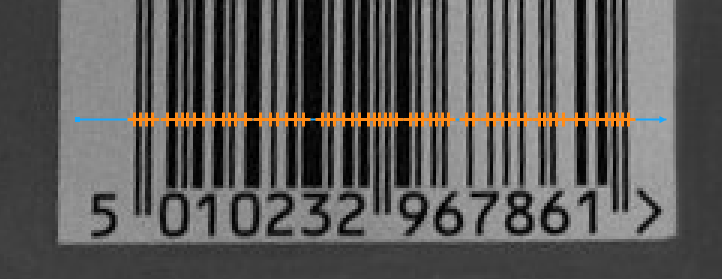You are here: Start » AVL.NET » Function Reference » Computer Vision » 1D Edge Detection » AVL.ScanMultipleEdges_Direct
Locates multiple transitions between dark and bright pixels along a given path (without a scan map).
| Namespace: | AvlNet |
|---|---|
| Assembly: | AVL.NET.dll |
Syntax
public static void ScanMultipleEdges_Direct ( AvlNet.Image inImage, AvlNet.Path inScanPath, AvlNet.CoordinateSystem2D? inScanPathAlignment, int inScanWidth, AvlNet.SamplingParams inSamplingParams, AvlNet.EdgeScanParams inEdgeScanParams, float inMinDistance, float? inMaxDistance, AvlNet.LocalBlindness? inLocalBlindness, IList<AvlNet.Edge1D> outEdges, IList<AvlNet.Gap1D> outGaps, NullableRef<AvlNet.Path> outAlignedScanPath, NullableRef<AvlNet.Profile> outBrightnessProfile, NullableRef<AvlNet.Profile> outResponseProfile )
Parameters
| Name | Type | Range | Default | Description | |
|---|---|---|---|---|---|
 | inImage | AvlNet.Image | Input image. | ||
 | inScanPath | AvlNet.Path | Path along which the scan is performed. | ||
 | inScanPathAlignment | AvlNet.CoordinateSystem2D? | Adjusts the scan path to the position of the inspected object. Default value: atl::NIL. | ||
 | inScanWidth | int | <1, INF> | 5 | Width of the scan field in pixels. Default value: 5. |
 | inSamplingParams | AvlNet.SamplingParams | SamplingParams ( Interpolation: Bilinear SamplingStep: 1.0f SampleCount: Nil ) | Parameters controlling the sampling process. Default value: SamplingParams ( Interpolation: Bilinear SamplingStep: 1.0f SampleCount: Nil ). | |
 | inEdgeScanParams | AvlNet.EdgeScanParams | EdgeScanParams ( ProfileInterpolation: Quadratic4 SmoothingStdDev: 0.6f MinMagnitude: 5.0f EdgeTransition: BrightToDark ) | Parameters controlling the edge extraction process. Default value: EdgeScanParams ( ProfileInterpolation: Quadratic4 SmoothingStdDev: 0.6f MinMagnitude: 5.0f EdgeTransition: BrightToDark ). | |
 | inMinDistance | float | <0.0f, INF> | 0.0f | Minimal distance between consecutive edges. Default value: 0.0f. |
 | inMaxDistance | float? | <0.0f, INF> | Maximal distance between consecutive edges. Default value: atl::NIL. | |
 | inLocalBlindness | AvlNet.LocalBlindness? | Defines conditions in which weaker edges can be detected in the vicinity of stronger edges. Default value: atl::NIL. | ||
 | outEdges | System.Collections.Generic.IList<AvlNet.Edge1D> | Found edges. | ||
 | outGaps | System.Collections.Generic.IList<AvlNet.Gap1D> | Gaps between consecutive edges. | ||
 | outAlignedScanPath | AvlNet.NullableRef<AvlNet.Path> | Transformed input path. Can be null to skip this parameter calculation. | ||
 | outBrightnessProfile | AvlNet.NullableRef<AvlNet.Profile> | Extracted image profile. Can be null to skip this parameter calculation. | ||
 | outResponseProfile | AvlNet.NullableRef<AvlNet.Profile> | Profile of the edge (derivative) operator response. Can be null to skip this parameter calculation. |
Description
The operation scans the image along inScanPath and detects image edges perpendicular to the path. Depending on the inEdgeScanParams.edgeTransition parameter, edges representing increase or decrease (or both) of image brightness along the path will be taken into account.
When the number of edges to be found is known, one can use the ScanExactlyNEdges.
The optional parameter inScanPathAlignment defines a transform to be performed on the inScanPath so that the actual scan path (outAlignedScanPath) is adjusted to the position of the object, typically detected by one of Template Matching filters.
Note that in case of a scan path which is closed, the parameters controlling the distances between consecutive found objects do not control the distance between the first and the last of the found objects (counting from the beginning of the scan path).
Examples

ScanExactlyNEdges locates the edges across inScanPath.
Remarks
Read more about Local Coordinate Systems in Machine Vision Guide: Local Coordinate Systems.
This filter is a part of the 1D Edge Detection toolset. For a comprehensive introduction to this technique please refer to 1D Edge Detection and 1D Edge Detection - Subpixel Precision chapters of our Machine Vision Guide.
Function Overrides
- ScanMultipleEdges_Direct(Image, Path, Int32, SamplingParams, EdgeScanParams, Single, IList<Edge1D>, IList<Gap1D>)
- ScanMultipleEdges_Direct(Image, Path, Nullable<CoordinateSystem2D>, Int32, SamplingParams, EdgeScanParams, Single, Nullable<Single>, Nullable<LocalBlindness>, IList<Edge1D>, IList<Gap1D>)
- ScanMultipleEdges_Direct(Image, Path, Nullable<CoordinateSystem2D>, Int32, SamplingParams, EdgeScanParams, Single, Nullable<Single>, Nullable<LocalBlindness>, IList<Edge1D>, IList<Gap1D>, Path, Profile, Profile, IList<Path>, Single)
- ScanMultipleEdges_Direct(Image, Path, Nullable<CoordinateSystem2D>, Int32, SamplingParams, EdgeScanParams, Single, Nullable<Single>, Nullable<LocalBlindness>, IList<Edge1D>, IList<Gap1D>, NullableRef<Path>, NullableRef<Profile>, NullableRef<Profile>, IList<Path>, Single)

